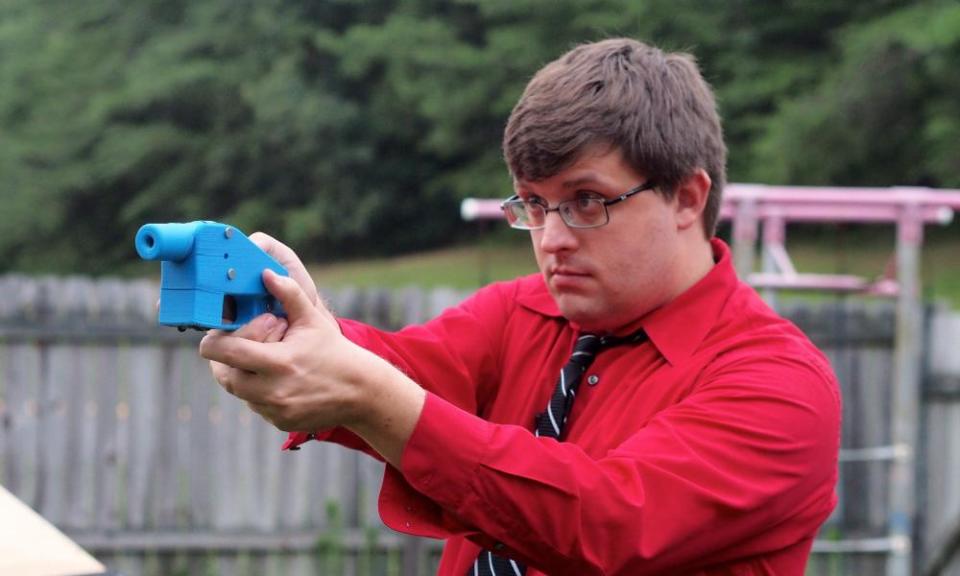'I wouldn't waste my time': firearms experts dismiss flimsy 3D-printed guns
The plastic weapons require high-end printers and are known to blow up in shooters’ hands – but they could pose a future threat

As the day has neared for the release of blueprints for printing 3D weapons, there has been a flurry of last-minute activity and expressions of concern from US lawmakers. Even the president weighed in with a Tuesday morning tweet that seemed to question his own administration: “I am looking into 3-D Plastic Guns being sold to the public. Already spoke to NRA, doesn’t seem to make much sense!”
And now, in the last hours, a federal judge in Seattle has issued a temporary restraining order to stop Cody Wilson, who produced the world’s first 3D-printed gun in 2013, from making his controversial plans available for download.
Officials are worried that these “ghost guns” lack serial numbers, making them untraceable by law enforcement, and that plastic weapons may be impervious to metal detectors in airports. DIY firearms may also render existing gun regulations virtually moot. People who might normally be prevented from legally owning a gun, such as convicted felons or the mentally ill, could skirt such restrictions by printing them at home.
At least in theory, that is. In practice, however, it’s not quite as easy as it sounds and 3D guns, some experts say, aren’t worth the trouble or risk of a weapon blowing up in your hand.
3D printers work by melting or fusing raw materials such as plastics or metals at high heat, then laying down successive layers of the material in a specific pattern determined by software. This is also known as additive manufacturing, and it’s used to produce simple objects like toys, prototypes of industrial products, human medical implants, and jet engine fuel nozzles.
Downloading the code for printing an AR-15 or M9 Beretta is merely the start. Opening and manipulating the file requires computer-aided design software and a fair amount of expertise. A user would also need a high-quality 3D printer, which can cost $10,000 or more.
“A typical 3D desktop printer is not up to the task,” said Pete Basiliere, research vice-president for additive manufacturing at the Gartner consulting firm. “It probably won’t have the quality of build to make the gun safe. Even if the quality is acceptable, the range of materials that are used in an extrusion printer are so limited that there’s a great risk of the gun misfiring in your hand.”
In fact, a 3D-printed plastic firearm may prove a greater danger to the person holding it than anyone standing in front of it, said Terry Wohlers, president of Wohlers Associates, an additive manufacturing consultancy.
“My biggest fear is that innocent people will believe it’s fine to download the data for a gun, take it out for target shooting, and then they or someone else is injured inadvertently,” he said. “The fact that this part of the work has been done for you would encourage people of all types to consider printing a gun and seeing what happens.”
In 2013, police in New South Wales, Australia, manufactured copies of Wilson’s original 3D gun, known as the Liberator, using a $1,700 desktop printer. They then placed it in a vise and fired it multiple times, using a wire to pull the trigger. Each time, the gun blew up as the bullet left the chamber.
In 2015, the state passed a law banning the possession of files that could be used to produce 3D-printed guns.
Producing a gun using a metal 3D printer would probably result in a higher quality weapon but at a much greater cost, noted Basiliere. Additive manufacturing machines that can use steel, aluminum, nickel, or other metal powders start at well over $100,000.
“A person who wants to make a metal gun needs access to a very expensive machine that is not simple to operate,” he said. “If your gun-making is above board, you can work with whoever owns that machine. But if you’re thinking about making a gun for criminal intent, you’ll need to find a machine and go about it in a secretive way.”
So far, the prospect of downloading and printing a gun at home seems to be generating more excitement from lawmakers than gunmakers.
“I wouldn’t waste my time on them,” said Phil Wong, an NRA-certified firearms instructor in Tucson, Arizona. “If I want to have something fun to use at the range, I’d rather spend the money on a new gun. Unless you spend several hundred thousand dollars on a metal-capable 3D printer, you’re getting something plastic that’s nowhere near as durable and strong as forged ordnance-grade steel.”
Or someone can simply go out and buy a gun, legally or otherwise, more cheaply and easily than building their own, said Jeremiah Blasi, a gun safety instructor for owner of Guardian Shooting Solutions in Broken Arrow, Oklahoma.
“I’m not interested in 3D guns because there are plenty of ways to obtain legal firearms I can actually use,” he said. “Even if our government was to ban firearms today, it would still not be difficult to get access to illegal weapons, and they’d be a lot more effective than the 3D-printed models.”
Will we ever get to the point where printing a gun at home is as easy as printing a photo?
Probably, said Max Lobovsky, CEO of Formlabs, one of the first companies to market low-cost professional 3D printers. But that won’t happen for some time.
“In 10 or 15 years, we’ll probably have a low-cost device that can produce fairly complete firearms or other weapons,” said Lobovsky. “And maybe this is something our government’s policies should address today. But right now it’s so easy to acquire a gun that it doesn’t make sense to make one at home.”
Related Video: Federal Judge Blocks Release of Gun Plans Online
Watch news, TV and more on Yahoo View.

